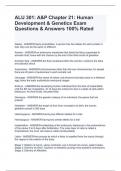Exam (elaborations)
ALU 301: A&P Chapter 21: Human Development & Genetics Exam Questions & Answers 100% Rated
- Course
- Institution
Amnion - ANSWER-an embryonic membrane that holds the fetus suspended in amniotic fluid; fuses with the chorion by the end of the third month of gestation Amniotic fluid - ANSWER-the fluid contained within the amnion; cushions the fetus and absorbs shock Autosomes - ANSWER-chromosomes other th...
[Show more]



